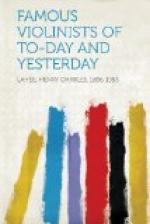Violin literature owes much to Viotti, for his compositions are numerous and contain beauties that have never been surpassed. His advice was sought by many young musicians, and among these was Rossini, who was destined to become great. De Beriot also sought out Viotti and played before him, but the old violinist told him that he had already acquired an original style which only required cultivating to lead to success, and that he could do nothing for him.
Viotti was one of the first to use the Tourte bow, and he studied its effects closely, so that the sweep of his bow became his great characteristic, and was alike the admiration of his friends and the despair of his rivals. He died in 1824, after about two years of retirement.
Among Viotti’s most prominent pupils were Roberrechts, Pixis, Alday le jeune, Cartier, Rode, Mori, Durand, and Baillot, also Mlle. Gerbini and Madame Paravicini. Roberrechts became the teacher of De Beriot, who in turn taught Vieuxtemps, Teresa Milanollo, and Lauterbach. Baillot taught Habeneck, who taught Alard, Leonard, Prume, Cuvillon, and Mazas. From Alard we have Sarasate, and from Leonard, Marsick and Dengremont, while through Rode we have Boehm, and from him a large number of eminent violinists, including G. Hellmesberger, Ernst, Dont, Singer, L. Strauss, Joachim, Rappoldi. Some of them we shall refer to at length as great performers, others were celebrated more as teachers.
Rodolphe Kreutzer, who was born at Versailles in 1766, is the third in order of development of the four great representative masters of the classical violin school of Paris; the others being Viotti, first, Rode, second, and Baillot, fourth. With Baillot he compiled the famous “Methode de Violon” for the use of the students at the Conservatoire. Kreutzer’s first teacher was his father, who was a musician in the king’s chapel, but he was soon placed under Anton Stamitz, and at the age of thirteen he played a concerto in public, with great success. This is said by some writers to have been his own composition, though by others it was attributed to his teacher.
Kreutzer made a tour through the north of Italy, Germany, and Holland, during which he acquired the reputation of being one of the first violinists in Europe. On his return to Paris, he turned his attention to dramatic music, and composed two grand operas, which were performed before the court, and secured for him the patronage of Marie Antoinette. He also became first violin at the Opera Comique, and professor at the Conservatoire, where he formed some excellent pupils, among them being D’Artot, Rovelli, the teacher of Molique, Massart, the teacher of Wieniawski and Teresina Tua, and Lafont, who also became a pupil of De Beriot. On Rode’s departure for Russia, Kreutzer succeeded him as solo violin at the Opera, later becoming Chef d’Orchestre, and after fourteen years’ service in this capacity he was decorated with the insignia of the Legion of Honour, and became General Director of the Music at the Opera. In 1826 he resigned his post and retired to Geneva, where he died in 1831. Kreutzer was a prolific composer, and his compositions include forty dramatic works and a great number of pieces for the violin.




